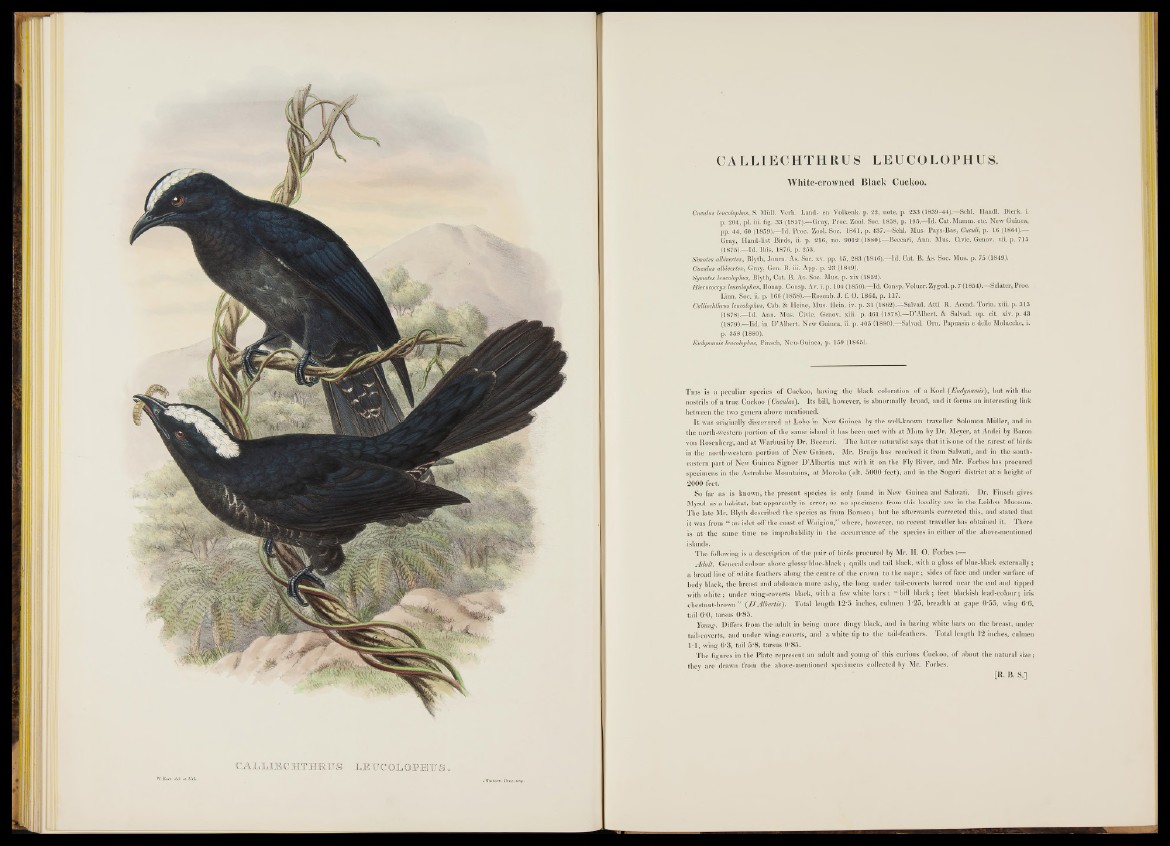
CALLIECHTH RU S LEUCOLOPHUS.
White-crowned Black Cuckoo.
Oucuiiis leucolophus, S. Mull. Verh. Land- en Volkenk. p. 22, note, p. 233 (1839-44).—Schl. Handl. Dierk. i.
p. 204, pi. iii. fig. 33 (1857).—Gray, Proc. Zool. Soc. 1858, p. 195.—Id. Cat. Mamm. etc. New Guinea,
pp. 44, 60 (1859).— Id. Proc. Zool.Soc. 1861, p. 437—Schl. Mus. Pays-Bas, Cuculi, p. 16 (1864).—
Gray, Hand-list Birds, ii. p. 216, no. 9012 (1880);—Beccari, Ann. Mus. Civic. Genov, vii. p. 715
(l875E~ Id. Ibis, 1876, p. 253.
Simotes albivertex, Blyth, Jourri. As. Soc. xv. pp. 15, 283 (1846).— Id. Cat. B. As. Soc. Mus. p. 75 (1849).
Cuculus albivertex, Gray, Gen. B. iii. App. p. 23 (1849).
Symotes leucolophus, Blyth, Cat. B. As. Soc. Mus. p. xix (1852).
Hierococcyx leucolophus, Bonap. Consp. Av. i. p. 104 (1850).—Id. Consp. Volucr. Zygod. p. 7 (1854).—Sclater, Proc.
Linn, Soc. ii. p. 166 (1858).—Rosenb. J. f. O. 1864, p. 117.
Calliechthrus leucolophus, Cab. & Heine, Mus. Hein, iv. p. 31 (1862).—Salvad. Atti R. Accad. Torin. xiii. p. 313
(1878).—Id. Ann. Mus. Civic. Genov, xiii. p. 461 (1878).—D’Albert. & Salvad. op. cit. xiv. p. 43
(1879),—lid. in D’ Albert. New Guinea, ii. p. 405 (1880).—Salvad. Orn. Papuasia e delle Molucche, i.
p. 358 (1880).
Eudynamis leucolophus, Finsch, Neu-Guinea, p. 159 (1865).
T h is is a peculiar species o f Cuckoo, having the black coloration of a Koel ( Eudynamis) , but with the
nostrils of a true Cuckoo (Cuculus). Its bill, however, is abnormally broad, and it forms an interesting link
between the two genera above mentioned.'
I t was originally discovered at Lobo in New Guinea by the well-known traveller Solomon Muller, and in
the north-western portion o f the same island it has been met with at Mum by Dr. Meyer, a t Andei by Baron
von Rosenberg, and a t Warbusi by Dr. Beccari. The latter naturalist says that it is one o f the rarest o f birds
in the north-western portion o f New Guinea. Mr. Bruijn has received it from Salwati, and in the southeastern
part o f New Guinea Signor D ’Albertis met with it on the Fly River, and Mr. Forbes has procured
specimens in the Astrolabe Mountains, at Moroka (alt. 5000 feet), and in the Sogeri district a t a height of
2000 feet.
So far as is known, the present species is only found in New Guinea and Salwati. Dr. Finsch gives
Mysol as a habitat, but apparently in error, as no specimens from this locality are in the Leiden Museum.
The late Mr. Blyth described the species as from B orneo; but he afterwards corrected this, and stated that
it was from “ an islet off the coast of Waigiou,” where, however, no recent traveller has obtained it. There
is a t the same time no improbability in the occurrence o f the species in either o f the above-mentioned
islands.
The following is a description of the pair o f birds procured by Mr. H. O. F o r b e s—
Adult. General colour above glossy blue-black; quills and tail black, with a gloss o f blue-black externally;
a broad line o f white feathers along the centre o f the crown to the nape ; sides o f face and under surface of
body black, the breast and abdomen more ashy, the long under tail-coverts barred near the end and tipped
with white; under wing-coverts black, with a few white b a rs : “ bill black; feet blackish lead-colour; iris
chestnut-hrown ” (D'Albertis). Total length 12-5 inches, culmen 1-25, breadth a t gape 0*55, wing 6-6,
tail 6 0 , tarsus 0 ‘85.
Youno-. Differs from the adult in being more dingy black, and in having white bars on the breast, under
tail-coverts, and under wing-coverts, and a white tip to the tail-feathers. Total length 12 inches, culmen
T l , wing 6-3, tail 5 '8 , tarsus 0 ‘8o.
The figures in the Plate represent an adult and young o f this curious Cuckoo, o f about the natural size;
they are drawn from the above-mentioned specimens collected by Mr. Forbes.
[R. B. S.]